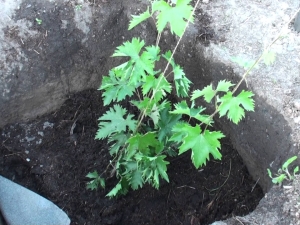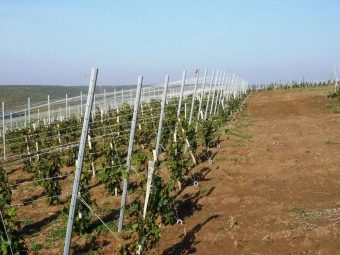At what distance to plant grapes?

Before planting any garden culture, it is necessary to thoroughly study the process of planting and care. Since it is these processes that directly affect what kind of crop will be obtained in the end.Of course, in this case, the important role played by the experience of other gardeners. However, practice shows that from year to year they make the same mistakes, the elimination of which can increase the yield by several times. Especially when it comes to grapes.
Immediately before the planting process, you need to carefully plan all subsequent actions, taking into account all the nuances that may affect the growth, development and fruiting of the plant.
Impact factors
To make the result of work pleasant You should do the following in advance:
- select suitable planting material;
- assess the condition of the soil throughout the site, the degree of its fertility and suitability for planting grapes;
- plan the necessary measures for the care of the bushes and their approximate dates;
- determine the degree of soil moisture and method of irrigation.
Answers to the above tasks will help to correctly determine the distance between future bushes. This value is affected by many nuances that cannot be underestimated. Even if you want to plant a few bushes in the country, on trial, you should not plant them at random. Yes, with good luck, even accidentally planted bushes bear fruit. But if all the necessary conditions are met, their quantity and quality will certainly increase. If the results obtained are unsatisfactory, it will not be possible to replant the plants.
To correct the picture is only one way - by removing the bushes through one, thus the distance between adjacent bushes can be increased, but the area will be spent irrationally. Otherwise, you have to uproot the landing and start all over again, spending a lot of time and effort almost wasted.
Timing
Another factor affecting the location of the vines is planting time. As a rule, it is produced in such periods as:
- in the spring - usually it is the period from the second half of April to mid-May;
- in the autumn - October or early November.
It should be said that these time periods depend on the climatic conditions of the region in which the vineyard is planned to be broken, so they can shift. The main criteria are the degree of soil warming or, conversely, the onset of early frosts.
Do not think that grapes can be grown only in the southern regions. Special varieties adapted for central Russia give an excellent harvest, if not delayed with the planting dates and made everything on time.
In spring, seedlings are planted with an open or closed root system. The first - earlier, because for their rooting takes more time. Planting material, even hardened by light and air, requires more heat during the growing season. All work should be done before the beginning of the movement of juices and rapid growth. They plant cuttings in the autumn, since by that time all processes in the plant are slowed down, adaptation to new conditions is easier. To avoid freezing, the landing should be properly insulated. To do this, you can use lapnik, sawdust, straw and even polyethylene.
Sorta
When marking the plot for grapes, it is important to consider which variety was selected, namely:
- sprawling, vigorous bushes should be located at a distance of three to four meters from each other;
- for sredneroslyh this figure is about three meters;
- for undersized - from one and a half meters.
If one row is planned, the landing direction can be arbitrary. If there are several rows, it is necessary to start from north to south. Distributing seedlings, it should be borne in mind that higher plantations should be located on the north side. Stunted options are located on the south side. In addition, it is necessary to alternate cuttings of pollinator varieties with same-sex flowers.
Depending on the climatic conditions, you can stop the choice on early, mid-season and late-ripening varieties.If the grapes fruit early, for him a large space is not needed.
Late, more powerful and cold-resistant varieties with long sleeves require more space around them. If the plantings are thick, the vine will grow crookedly and the work carried out with it will be hampered due to lack of space.
Planting later varieties at a distance of less than three meters is possible only in the case of constant monitoring and cutting off excess shoots.
In addition, there is a big difference in planting between generally available and selective varieties. The latter are used in large farms. Their planting, watering and processing is carried out in a mechanized way that standardizes the distance between the rows and the individual seedlings in them. On a production scale, more frequent planting is compensated by careful breeding, as well as subsequent selection of planting materials, balanced mineral supplements and competent irrigation system.
In very limited areas you can meet planting seedlings at a distance of up to a meter between each other. Harvest under such conditions is possible, albeit not fully, as well as thick plantings require great effort. For beginners, it is better to choose two or three varieties of different characteristics and try your hand.
Choice of place
To get a rich harvest at the end of the season, when placing grapes should consider a few tips.
- Plot for growing grapes should be chosen carefully. It should have good lighting, without tall fruit trees. The minimum distance to them should be at least three and a half meters, and the more - the better. Often bushes have along buildings or fences. In this case, you should make sure that it was the sunny, not the shadow side.
- It is worth paying attention to groundwater. Being close to the surface of the earth, they can lead to the death of seedlings. Moreover, such a soil deeply freezes through, contains cavities, therefore, in this case, planting in a ridge is used, which increases the distance to the underlying water. At the base of the pit, a sand-gravel mixture is necessarily laid. And on the sides of the site are digging drainage grooves for drainage.
- The composition of the soil depends on the amount of applied substances and fertilizers, as well as the planting scheme. Peat and clay soil for grapes is not suitable. Ideally, a place with sandy soil or ground, including crushed stone for good drainage and a fertile top layer, is needed. In addition, the soil should be slightly alkaline, with low acidity.
- Soil fertility directly affects the distance between seedlings. It should be at least 2 m in a more fertile area, which can give food to a rather sprawling bush. And much less if the soil is less suitable for growing this crop.
- Very often gardeners seek to fill the aisle with benefit. Indeed, when the area of the summer cottage is limited, and the distance between the rows is on average between two and three meters, there is a desire to sow it with at least grasses, and even more vegetables in the farm. However, this should be done carefully. Significantly lean, which means - to take away the nutrients that most garden crops are capable of. Some wild plants, such as sow thistles, mustard, bitter wormwood, nettle, can adversely affect the growth of grapes. And also you should not plant such flowers as a bell, a carnation, a calendula near a vineyard.
- Good neighborhoods are legumes and melons, as well as cereals. In the fight against diseases that are susceptible to grapes, you can plant a number of dill, sorrel, strawberries or celandine. The greatest benefit will bring roses. Usually they are placed at the beginning of a row, especially since the methods of planting and leaving them are similar.
In order to maintain a proper level of humidity, the chosen place must be well ventilated in order to prevent moisture accumulation.For the same reason, especially during the period of active growth of the root system, it is necessary to ensure that no crust forms on the surface of the earth. You can fight it with the help of loosening and timely watering.
Scheme
For the most usual way of landing, it is necessary to dig a hole about one meter wide. In it the tube for watering is installed. At the bottom of a layer of not less than 15 cm lay drainage in the form of rubble, broken bricks, small stones. Then the upper fertile layer, shot here, is filled up, and a little higher - less fertile, from the same pit. The seedling itself is set at an angle on the hillock formed in the lower wet layer, along which the roots are spread. Above, you can temporarily put on a plastic bottle or any other device for preserving heat.
To shape the upper part of the bush, on both sides of the seedling, columns are driven in or dug in, about two meters high. The average distance between them should be 2–3 m, as well as the distance between the seedlings. At a distance of about half a meter between them the wire is stretched. Depending on the option of forming a bush, there may be several of them. All work on the preparation of the pit can be done in the fall.
If you plan to plant a fairly large plot with seedlings, you should pre-mark it with pegs and a rope. Instead of holes, it is better to use trenches in which rows will be planted seedlings. The distance between rows on average should not be less than two meters. As an alternative to giving, grapes can be placed at a distance of 30 cm from the fence or 50 cm from the basement of the building. But the distance between the seedlings still should not be already 1.5 meters. Even if you want to save - do not do this, because there is a risk to get not the result that we would like.
Tips experienced amateur gardeners will help to correctly calculate the distance for planting grapes.
































